In search of the water of Mars
Around 1870, astronomer Giovanni Schiapparelli claimed to have seen the canals of Mars with a telescope. This caused the imagination of several astronomy fans who considered these channels as artificial channels created by the being. In science fiction novels the Martians begin to appear and in 1898 H.G. Wells told in the War of the Worlds that technologically advanced Martians conquered the Earth.
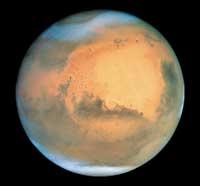
The idea that there is life on Mars was attractive, because for a while many people believed it. In the 1960s, however, the Mariner 4 spacecraft obtained the first images of Mars and demonstrated that the planet was purple. Thanks to the following Mariner missions, the atmosphere and geology of Mars were analyzed and, in the Vicking I and II missions carried out in the 1970s, data were collected in orbit and soil.
After investigating the traces, the researchers concluded that Mars was not alive, and thus ended the first flood of explorations.
Although no traces of life were found, there were scientific reasons to continue exploring the planet, and in 1992 NASA ordered the Mars Observer spacecraft to conduct geological, geophysical and climatic studies on Mars. After that, the results of the studies conducted on Earth reinforced the idea that on Mars there was life. For example, in 1996 researchers from NASA and the United States saw structures similar to fossilized bacteria in a Martian meteorite (although later it was not confirmed that they were remnants of living beings). On the other hand, on Earth, in uninhabited places, living beings were found, so it was demonstrated that in extreme conditions of temperature and pressure life can be created.
Mars Foz
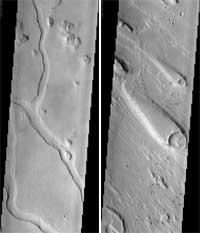
All this motivated NASA to consider Mars again as a destination. The Mars Global Surveyor mission, launched in 1992, obtained the most accurate images to date. They compared the geological structures that appeared in them with structures similar to those of the Earth, observing a great similarity with those generated by the water. It seemed to have been due to currents and floods, including lakes and oceans. However, there are no remnants of liquid water on the surface of Mars, as low atmospheric pressure and low temperatures on Mars prevent water from being liquid. Instead, there is water vapor in the atmosphere of Mars and ice at the poles.
However, for many researchers, these geological structures indicate that there was plenty of water on Mars. Consequently, at one time the temperature was going to be warmer and the atmosphere denser. But they can't explain why the weather changed and where all that water came in. Did everything evaporate or move under the ground? The pressure and temperature under the ground may be sufficient to allow liquid water to exist and trapped between the surrounding rocks.
According to other researchers, the origin of the surface geological structures of Mars was not water, but carbon dioxide. According to them, when coming out under the ground, carbon dioxide became gas by the change of pressure. The clouds of gas thus formed, moved at high speed, eroded the soil and formed cannons. This theory is more credible because otherwise it would take too much water and with a liter of carbon dioxide you get much more gas than with water.
A more direct sign of water

It is clear that to know if there has ever been water on Mars or still exists, it is more appropriate to make direct measurements than to interpret geological structures. Therefore, one of the tasks of the Mars Odyssey mission launched last year by NASA is the search for water ("Follow the water"). The gamma ray spectrometer that carries the spacecraft is able to measure the abundance and distribution of 20 chemical elements: hydrogen, silicon, oxygen, iron, magnesium, potassium, aluminum, sulfur, carbon and calcium, among others. If they know where and how much there is, they hope to understand the past and present of Mars.
And just beginning to analyze the first measurements, there has been a surprise that in the two areas near the poles, under the surface layer, a significant presence of hydrogen has been detected. In addition, these areas coincide with areas where ice is believed to be stable. According to researchers at the US Los Alamos Laboratory, this hydrogen can be aqueous. According to this, under the soil of Mars there would be a lot of water and so many media have released.
However, the data must be differentiated from the interpretation of the data, since when no water evidence has yet been found, some are saying that humans who will be sent to Mars will have no problems with the water supply. However, the interpretation that has been made from the hydrogen measurements of the spectrometer seems reasonable, although it will have to be confirmed by directly measuring the water.
Spectrometer for hydrogen
The gamma ray spectrometer consists of three meters: gamma ray sensor, neutron spectrometer and high-energy neutron detector. The sum of the measurements of these three instruments allows to know the presence and distribution of hydrogen in the Martian soil. But what exactly does the spectrometer measure?
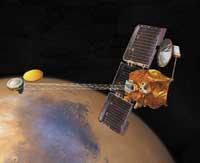
The process begins when cosmic rays pass through the atmosphere of Mars and collide with the skin. Cosmic rays are particles of very high energy level that move in the space at an almost luminous speed, especially protons. By hitting any atom on the surface of Mars, shock generates other particles through the process called spacing. These particles are mainly neutrons and other protons, and although they are very fast, they do not have the same speed as the initial cosmic rays. These second protons, on the other hand, attack other atoms and cause more particles. This chain reaction crosses the first meters of Mars soil.
As for the spectrometer, the most interesting are neutrons. In each shock they lose energy, slow down and finally move at a speed similar to that of surface atoms. That is, rapid neutrons become thermal neutrons. If they stain, any atom can assimilate them, even hydrogen.
When an atom acquires a thermal neutron, a specific gamma ray of the atom is emitted. Therefore, the gamma ray spectrometer allows the atom to be identified. This has been one of the methods used to detect hydrogen on Mars.
The other method is through neutron spectrometer and high-energy neutron detector. These devices detect neutrons and classify them into three levels of energy: rapid (produced after the spallation of cosmic rays, of high energy level), epithermal (intermediate) and thermal (slower). This loss of energy occurs in the collision with other atoms and, precisely, hydrogen is especially effective in stopping neutrons, since its mass is almost equivalent to that of neutral. Therefore, when there is a lot of hydrogen, neutrons quickly lose speed, and epithermal and rapid neutrons remain few. This has been proven in the measurements of the neutron spectrometer and the high-energy neutron detector.
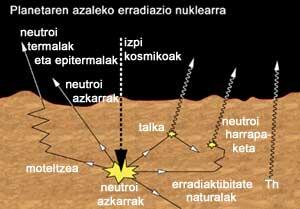
Is hydrogen from water?
In the analyzed area, as it approaches the south pole the gamma ray signal of hydrogen increases, while the epithermal neutrons decrease. All this indicates that the closer the pole the more hydrogen there is. But knowing how hydrogen is distributed on the surface is not so simple. For this they have developed different models representing the surface of Mars in one or two layers. For elements other than hydrogen, measurements of the Mars Pathfinder spectrometer have been used, which emerged in 1996, taking as a unit a soil of 1% water by weight. So they have seen which model best fit measurements.

The researchers conclude that in the soil of Mars there are two layers, the upper dry and the lower wet (the weight of the rocks would be 35-50% water). This humidity is noticeable between latitudes 45º and 60º, increasing when approaching the poles. Although the data conforms to this model, NASA researchers have recognized that it is not the only solution, and that it is probably much more complicated because they have neglected many difficulties, for example, soil composition will be variable, unlike the model.
While the identified element is certain to be hydrogen, the chemical form in which it is found is more debatable. It is believed that the hydrogen of the upper layer can be water or hydroxide physically or chemically associated, while in the lower layer there is no other alternative than frozen water. To begin with, the minerals that form the rocks cannot contain so much water. On the other hand, the difference between layers is high in terms of humidity, and the simplest way to explain it is the evaporation of the ice existing at the top.
In addition, the places where theoretical studies predicted the presence of ice are the ones that contain the most hydrogen.
Considering all this, and seeing that it coincides with the data taken by the spectrometer, it is quite certain that there is a lot of water in the layer below 10 cm of the surface of Mars. The spectrometer has an approximate resolution of 1 meter, but according to NASA it is very possible that the soil of Mars is a large water tank.
Looking forward
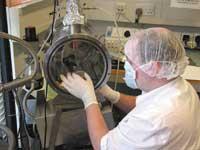
The Mars Odyssey mission, which still has many functions, will undoubtedly collect important data that will then help to understand Mars. In addition, the discovery of water will give a great boost to the upcoming NASA missions, for which the organization will more easily receive the necessary subsidy. Next year he wants to install on Mars two vehicles for the analysis of minerals and water.
However, Mars has not only been interested in NASA, since in the years 2003-2004 it will have around six international spacecraft. Among them, the European Space Agency (ESA) will launch the Mars Express project, in which another vehicle, the Beagle 2, will be able to take soil samples. It seems that we will not have to wait too long to know if there is water or not.

The water of Mars? These experiments cannot differentiate hydroxides from hydroxides with OH. Infrared observations have shown that hydrates predominate in the skin, but logically it is measured from the surface at a shallow depth, so they cannot say anything about a hydrogen at a meter depth. However, in my opinion, if carbohydrates predominate on the surface, it is quite possible that in the subsoil there are other situations. A problem for the future is that if missions want to use this icy water, what we see may not be just dirty, filterable and washable water, but it may be chemically related and therefore liberable only from chemical reactions. This can bring logistics problems! Measurements are different ways of giving direct evidence and, in this case, although only hydrogen is measured, analyzing the history of Mars and the geological and chemical context, it can be considered that H is in H 2 O. Of course, that evidence is not as good as direct observation, but in my image it is evidence. On the surface of Mars there was a lot of water in the past, as shown by its geological structure, and we do not know exactly where it has gone, but we have two ideas: on the one hand, much water vapor was lost in the past, when Mars lost much of the atmosphere, and on the other, due to the abundance of porous minerals on the surface, much water was filtered into the subsoil. These ideas coincide with the observations made and intuitively confirm what we expected. On the other hand, the cycles of CO 2 and those of H 2 O are important in the atmosphere of Mars, so considering the predominant chemical composition of the planet, if the hydroxides were underground would predominate carbon dioxide, very volatile gas that is not found in large quantities. Astronomer Mikel Susperregi |





